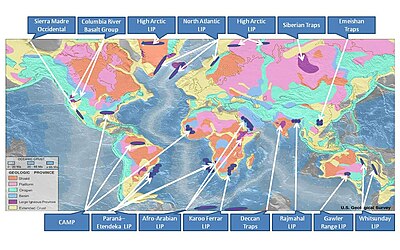
Back Groot magmaprovinsie Afrikaans إقليم ناري كبير Arabic Magmatische Großprovinz German Gran provincia ígnea Spanish Suur magmaprovints Estonian Laakiobasaltit Finnish Province magmatique French משטח בזלת נרחב HE बड़े आग्नेय-चट्टानी क्षेत्र Hindi Provinsi beku besar ID

A large igneous province (LIP) is an extremely large accumulation of igneous rocks, including intrusive (sills, dikes) and extrusive (lava flows, tephra deposits), arising when magma travels through the crust towards the surface. The formation of LIPs is variously attributed to mantle plumes or to processes associated with divergent plate tectonics.[1] The formation of some of the LIPs in the past 500 million years coincide in time with mass extinctions and rapid climatic changes, which has led to numerous hypotheses about causal relationships. LIPs are fundamentally different from any other currently active volcanoes or volcanic systems.
© MMXXIII Rich X Search. We shall prevail. All rights reserved. Rich X Search